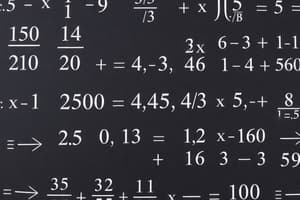Podcast
Questions and Answers
Rational numbers can be expressed as a ratio of two ______
Rational numbers can be expressed as a ratio of two ______
integers
A rational number is any fraction or ______ expressed using decimal points
A rational number is any fraction or ______ expressed using decimal points
integer
Rational numbers form a field under addition and ______ operations
Rational numbers form a field under addition and ______ operations
multiplication
All rational numbers lie between negative and positive ______
All rational numbers lie between negative and positive ______
Whole numbers and integers are special cases of rational ______
Whole numbers and integers are special cases of rational ______
An integer is just a whole ______
An integer is just a whole ______
Simplification means reducing a rational number expression to its ______ possible terms, such as converting (\frac{-12}{18}) to -(\frac{2}{3}). Simplified forms help us understand relationships more clearly and perform easier arithmetic operations.
Simplification means reducing a rational number expression to its ______ possible terms, such as converting (\frac{-12}{18}) to -(\frac{2}{3}). Simplified forms help us understand relationships more clearly and perform easier arithmetic operations.
Just like integers, we ______ rational numbers based on their magnitudes from smallest to largest values. This allows us to compare quantities, determine which is larger or smaller, and solve complex problems accordingly.
Just like integers, we ______ rational numbers based on their magnitudes from smallest to largest values. This allows us to compare quantities, determine which is larger or smaller, and solve complex problems accordingly.
To work with these basic algebraic operations, recall how you were taught to handle fractions back in elementary school! Fortunately, adding, subtracting, ______, and dividing remain consistent across integer, decimal, and mixed rational numbers.
To work with these basic algebraic operations, recall how you were taught to handle fractions back in elementary school! Fortunately, adding, subtracting, ______, and dividing remain consistent across integer, decimal, and mixed rational numbers.
Understanding rational numbers provides a strong ______ for understanding more advanced mathematics concepts.
Understanding rational numbers provides a strong ______ for understanding more advanced mathematics concepts.
By recognizing them for what they truly are – ______ and divisions – we foster a deeper appreciation for mathematics beyond mere computations.
By recognizing them for what they truly are – ______ and divisions – we foster a deeper appreciation for mathematics beyond mere computations.
When working with real-world problems involving measurements, many people initially look at decimal representations like 7.29 or -5.12. These decimal expressions make up one type of ______ number: those expressible via dot notation.
When working with real-world problems involving measurements, many people initially look at decimal representations like 7.29 or -5.12. These decimal expressions make up one type of ______ number: those expressible via dot notation.
Flashcards are hidden until you start studying
Study Notes
Rational Numbers: Uncovering Fractions with Purpose
Rational numbers form the backbone of our daily mathematical calculations and reasoning – they're responsible for simplifying division results into manageable forms. Let's explore this world of fractions by looking through one-word answers related to their entire chapter.
Definition
A rational number is any fraction (like (\frac{1}{2})) or integer (such as -7) expressed using decimal points and finite decimals ((8.4)). It can also be represented as a ratio of two integers ((\frac{a}{b})), where (b\neq 0). In other words, it's a number that can be written as a quotient of two integers without leaving a remainder when divided.
Properties
Rational numbers have several unique properties:
- They form a field under addition and multiplication operations. A field refers to a set with specified operations that follow specific rules.
- All rational numbers lie between negative and positive infinity, forming a continuous ordered line segment.
- Whole numbers and integers are special cases of rational numbers; therefore, every integer has a corresponding rational number representation.
Integer Form
An integer is just a whole number (positive, negative, or zero); however, we represent all integers as rational numbers because we emphasize the divisibility aspect. For example, you may think of -6 simply as being six less than zero, while mathematically, it could be seen as dividing seven by (-1), yielding -(\frac{7}{1}=-)7.
Decimal Form
When working with real-world problems involving measurements, many people initially look at decimal representations like 7.29 or -5.12. These decimal expressions make up one type of rational number: those expressible via dot notation.
Simplification
Simplification means reducing a rational number expression to its lowest possible terms, such as converting (\frac{-12}{18}) to (-\frac{2}{3}). Simplified forms help us understand relationships more clearly and perform easier arithmetic operations.
Ordering
Just like integers, we order rational numbers based on their magnitudes from smallest to largest values. This allows us to compare quantities, determine which is larger or smaller, and solve complex problems accordingly.
Addition, Subtraction, Multiplication, and Division
To work with these basic algebraic operations, recall how you were taught to handle fractions back in elementary school! Fortunately, adding, subtracting, multiplying, and dividing remain consistent across integer, decimal, and mixed rational numbers. Even irrational numbers – those nonterminating recurring decimal types – still fall within this framework since they can always be approximated by containing rational numbers.
Understanding rational numbers provides a strong foundation for understanding more advanced mathematics concepts. By recognizing them for what they truly are – ratios and divisions – we foster a deeper appreciation for mathematics beyond mere computations.
Studying That Suits You
Use AI to generate personalized quizzes and flashcards to suit your learning preferences.




